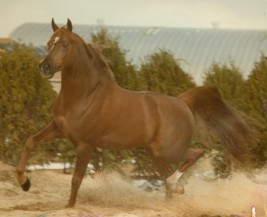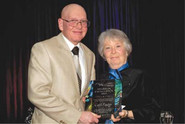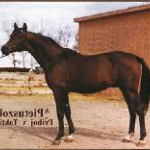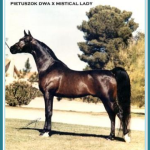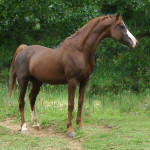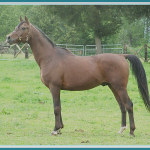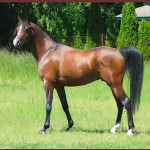GEORGE & LYNN ALLEN
WILLOMAR ARABIANS
301 Isbell Rd
Mossyrock, WA 98564
Phone: +1 360 983.8351
Email address:
WHAT'S NEW
Congratulations to Carl Fudge and Sturgeon Creek Arabians on receiving Equine Canada's award of excellence for their highly successful breeding of endurance horses utilizing the blood of Pyatigorsk. See link to full article
KUHAILAN ADJUZE SIRE LINE
ARABIAN TYPE
(originally published in 1985)
In the literature of the Arabian breed the word type has, in my opinion, caused more confusion than any other word. For the purpose of this essay we will define "breed type" as those characteristics that are specific and unique to the Arabian breed. These characteristics include the head, neck, top line, quality, and way of going. The head is to be triangular; it is to be wide at theeyes and refined at the muzzle.
A dish below the eyes is desirous; a Roman nose is most undesirable. The eyes should be large, soft, and set well apart. The neck should be well shaped, clean at the throat latch and very mobile at the pole. The top line should be quite flat with emphasis on a short strong back and powerful croup. Quality includes dryness; i.e. the skin being very tight over the rest of the body and a soft hair coat. The motion should be elegant, very elastic, and liquid in its portrayal.
There are very practical reasons for all of the above characteristics, An attractive triangular head with large eyes that are well set apart indicates intelligence and a desire to please. Since the
neck and head are the horses balancing mechanism, the neck needs to be clean at the throat latch and well hinged at the pole to allow the horse to stay in balance with ease.
A short strong back indicates a clean line for the energy of impulsion to travel and drive the horse forward, Length ofcroup, and the depth of hip and croup, are important for the horse to perform as an athlete. Dryness is that quality that expresses hard dry dense bone. hard dry tendons and ligaments, clean joints and a soft supple skin and hair coat.
These characteristics were what attracted early day cavalry men to include the Arabian breed in the production of their horses, for these characteristics were what gave soundness to their horses in the long marches. In the desert. the horse was bred to be an athlete and often the horses life depended on this ability. When all ofthecharacteristics of type are in place and are in harmony. then liquid fluid motion, the kind that could cover desert sand all day, is the result.
If we are then to apply the above definition of ope to the horses we come in contact with today, we then need to recognize that the breed is made up world-wide of a number of different "types" or flavors of Arabian horses within the "breed type".
This occurred because each tribe from Arabia created a different "type", or flavor to suit their own purposes (much as we create different types of automobiles). To use terminology that is common in Europe, these different types are identified by the names: Kuheilan, Seglawi, Managhi, Hadban, and
others that are lesser known.
The Arabian breed is a very old breed and due to the physicality of its origin (i.e. isolation in the desert over a long time and especially isolation of the individual tribes), the genetic base of the breed is very concentrated and the various types are therefore genetically very prepotent. It is therefore of great importance that the creative breeder recognizes the various types and their contribution to the whole.
It is not productive for the breeder to judge all horses in the breed against one type, or model, for in doing so the breeder eliminates much of value that could contribute to his or her program.
As an example, Negatiw was by the noted Seglawi sire Xaseem, and out of a Menaghi mare, yet he contributed greatly as a sire of significance in both Russia and Poland siring horses of Excellent Seglawi type, Seglawi horses are of strong oriental type, having triangular heads s, large expressive eyes, well shaped necks, very round body parts. and great beauty.
Common examples of this model are the Raffles and Skowronek bred horses. the Naseem bred horses such as Negatiw and his offspring, and many of the horses originating from the Abbas Pasha stud.
The Kuhailan horses usually have more elongations through the head and are more angular in structure, often with more emphasis on a strong s~ stem of levers, They are often longer through the croup and hip area with some slope to the croup.
Examples of this flavor are the Kuhailan Ham horses such as Bask. to include many of his offspring, and the Priboj horses such as Pietuszok. Horses of the Hadban flavor are horses of good size with large muscle mass, substantial bone, and a good system of levers.
Their heads are expressive but often somewhat large. Examples of this flavor are some of the Crabbet horses such as Nuredinn and Berk, The Managhi flavor horse, while not very common in America are important to the breed as a whole. These are horses with a very strong system of levers, great angulation, longish and rather plainish heads, great stamina, and great speed, Examples of this flavor are some of the horses of the Latif sire line including Kann and Korej.
In North America, the Seglawi horses became very popular in the 1950s and 1960s and then, as it were, breeders of this flavor of Arabian horse established the terms of "breed type" for the entire Arabian horse breed in North America in reference to their favorite flavor of horse!
Indeed, careful study will indicate that "breed type" at that time emanated from the Polish bred Skowronek, used in England by Lady Wentworth at Crabbet Park. Later, in the 1970s, with the importation of the Polish horses, Kuhailan type came to be recognized, though often judged with reference to Seglawi type rather than as Kuhailan. More recently, importations from Russia and France have introduced horses of the Managhi flavor which are outstanding athletes, but are again judged with reference to Seglawi type.
To be sure, then, we have four common and distinct types or flavors of Arabian horses. Plus we have combinations of the various types. It is up to the astute breeder, then, to determine as accurately as possible 'What types he or she is dealing with, and what combinations are most successful. As an example, strongly bred Kuhailan stallions cross well on Seglawi mares. Bask, when bred to many of the beautiful Siglawi mares of domestic breeding in this country produced many national champions. Interestingly enough, the opposite rarely holds true, i.e. breeding strongly concentrated Seglawi stallions to Kuhailan Haiti mares of good quality very rarely produces superior horses.
Certainly many of the artisans, i.e. the serious breeders of the breed, recognized the various types within the breed and utilized them on occasion. Line breeding Seglawi type in America was very common in the 50's and 60's and produced many wonderful horses. An example of these horses were those of Dan Gainey, who line bred strongly to a small number of superior Seglawi sires and thus fixed a specific Seglawi flavor as his landmark in the breed. It was interesting to watch him use Bask (Kuhailan) blood with little apparent success. However, when he introduced the Seglawi Kuhailan blood of Comet into his program, he and his family produced beautiful national champion athletes.
Now that we have established and defined the various types within the breed of the Arabian horse, the next task is to delineate the combinations of the above types that have proven to be successful in producing excellent horses. One of the most exciting combinations in the last 50 years was that of the Seglawi stallion Nabor (Negatiw x Lagodna) on the Seglawi bred Amurath Sahib daughters of Poland. An example of this cross was the multinational champion mare, Dornaba. Mares of this combination were famous all over the world. In line breeding Kuhailan type the Poles used the Kuhailan Adjuz stallion Pietuszok (priboj x Taktika) on their beautiful Witraz (Kuhailan Haifi) daughters and produced not only beautiful national champion offspring, but also Derby winning race horses.
Of more recent times, the Poles used the Seglawi son of Aswan, Palas (out of Panel by Nil), on many of their Seglawi mares and produced world champions such as Etmria (out of Etna). Panel was a daughter of Platina who was a full sister of Pietuszok.
In Russia, the breeders were highly successful in crossing the Seglawi blood of Naseem on the Kuhailan bred Priboj mares. Examples of this combination are Pustinia (Salon x Ptashka), Palmira (Salon x
Ptashka) and Muscat (Salon x Malpia), Mares and stallions of this combination have contributed greatly to the breeding system in Tersk and in North America.
The Bairactar sire line, utilizing the small but exotically pretty bay Seglawi stallion Nabeg (Arax x Nomenklatura by Naseem), was then used on the Naseem Priboj mares. The offspring of this combination were often very pretty and most commonly of Seglawi type. As a general rule,few stallions of the Bairactar sire line are prepotent sires, and this proved to be the case in this combination with few exceptions. Here in North America, the Seglawi stallion Pesniar (Nabeg x Pesnia by Aswan) was used to cover a large number of Kuhailan Ham mares through Bask with very poor results in general. Again, Seglawi blood on Kuhailan Ham mares was not, as a rule, successful.
One would expect more breeding prepotency from colts by the Seglawi stallion Nabeg out of Seglawi mares such as Nariadnaia (Aswan x Nomenklatura by Naseem) and such proved to be the case. At Tersk
they used colts out of the good-sized Priboj Naseem mares to carry on the Bairactar sire line. Horses such as Peleng (Nabeg x Palmira by Salon) and Pesniar (Nabeg x Pesnia by Aswan) were
excellent examples.
The Bairactar sire line was carried on in Poland with the importation of Tallin (Nabeg x Talantiviaia by Aswan). He was used principally on Seglawi mares with good success and his grandson Emanor (by Wojslaw by Tallin) is the 1999 US National Champion stallion. Emanor is a horse of superb Seglawi type. It stands to reason then, that in our Arabian population we have horses line bred strongly to Kuhailan
type,horses line bred strongly to Seglawi type, and to a lesser extent, line bred to the other types.
There are also horses of Seglawi Kuhailan combination with Seglawi being the most obvious phenotypically (the visible properties of an organism that are produced by the interaction of the genotype
and the environment), and those that are Kuhailan Seglawi with Kuhailan being the most prominent phenotypically. It behooves the breeder, then, to understand what type he or she is dealing with in
relation to the pedigree in choosing viable matings with high chances of success.
At Willomar it has been our desire to produce horses of superb Arabian type that would be successful in classical athletic competition. To this end we have line bred Kuhailan type. We used the
linebred Kuhailan type stallion Pietuszok (Priboj x Taktika by Taki Pan), the linebred Kuhailan type stallion Rezus (Celebes x Rezeda by Czort), the Managhi type stallion EI Kasaka (patron x Purga by
Kankan), and the Kuhailan Seglawi stallion Pyatigorsk (pietuszok Dwa x Mystical lady by Tornado). In recent years we have added the Seglawi Kuhailan stallion Alkalia (Probat x Alka by Celebes) and
the Seglawi stallion Pistaschio (Salon x Panntera by Kniazj). Our brood mares are predominately linebred Kuhailan type. Too, one will
find a group of mares in our band linebred to Arax (Amurath Sahib x Angara) on the maternal side concentrating Kuhailan Seglawi type from the great mares of Arax. Only recently have we introduced
Naseem blood to our program with outstanding success, just as the Russians did so long ago on their Priboj mares.
Pyatigorsk, a significant sire of the Kuhailan Adjuz sire line of Russia and Poland, has been a principle sire in our program for many years. He crossed well with Kuhailan mares such as daughters of Bask, i.e. Star of Ofir and mares of the Seglawi I line including the daughters of Aswan and the daughters of EI Kasaka. Pyatigorsk was not particularly successful with the Seglawi mares of the Raffles branch of the Ibrahim sire line nor with mares of old Abbas Pasha breeding.
Pyatigorsk was always very useful on line bred Kuhailan mares of good quality. In our experience, stallions of the Naseem sire line are often difficult to train because of a short attention span. We
chose Pistaschio because he had been a successful race horse setting some track records and also he was out of the same family of mares that had produced Pietuszok and Topol. Some of his geldings
have become excellent 4-H horses which gives some indication of the soft quality of their minds. His foals out of strong minded mares are more difficult to train. He has produced exceedingly well
bred to daughters of Pyatigorsk, an example being Spirited Music out of Kalua by Pyatigorsk, presently racing in California.
Kuhailan type has been instrumental in producing horses of superb type and superb athletic ability. Kuhailan Haiti sire line horses are presently numerous in the Arabian horse population because of the tremendous success of the Bask bredhorses. The addition of Kuhailan Adjuz blood on these horses has been very successful in Europe and is worthy of consideration here.

